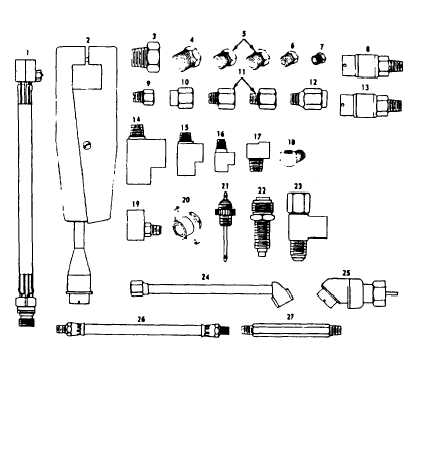| |
TM10-3930-660-20
TABLE 2-5 TRANSDUCER KIT CONTENTS
1 .
2.
3.
4.
5.
6.
7.
8.
9.
10.
11.
12.
13.
14.
15.
16.
17.
18.
19.
20.
21.
22.
23.
24.
25.
26.
27.
Hose Assembly TK10
Prod, Test TK1l
Reducer, Pipe TK12
Reducer, Pipe TK13
Reducer, Pipe TK14
Plug, Pipe TK15
Plug, Pipe TK16
Transducer (Blue)
O to 1,000 psi TK17
Adapter, Straight TK18
Reducer, Pipe TK19
Reducer, Pipe TK20
Dampener, Fluid TK21
Transducer (Red)
-30 in. hg to 25 psi TK22
Tee, Pipe TK23
Tee, Pipe TK24
Tee TK25
Elbow, Pipe TK26
Elbow, Pipe TK27
Tee, Pipe to Tube TK28
Adapter, Connector TK29
Adapter, Connector TK30
Adapter, Speedometer TK31
Tee, Pipe to Fuel Line TK32
Chuck, Inflating TK33
Tachometer, Pulse TK34
Hose Assembly TK35
Nipple, Pipe TK36
Refer to the manual provided with the STE/ICE kit for description and operation of
the VTM and the TK.
c.
STE/ICE Testing Procedures.
The vehicle test procedures consist of two test
sequences; GO-Chain Sequences and NO-GO-Chain Sequences.
A GO-Chain sequence
is a logical sequence of tests performed to determine the general condition of
the vehicle.
If the vehicle fails any of the GO-Chain tests, the test will
direct the user to a specific NO-GO test for further testing. The NO-GO tests
are used to isolate what is wrong with the vehicle.
The GO and NO-GO-Chain Sequences are presented as an illustrated flowchart with
test branching controlled by YES and NO decisions.
Generally, a YES
determination leads to the next test; a NO determination leads to NO-GO testing
and corrective action.
When the VTM interfaces with the vehicle through the Diagnostic Connector
Assembly (DCA) the test is titled DCA Mode Testing.
If the VTM interfaces with
the vehicle through the use of the transducer kit (TK), the test is titled TK
Mode Testing.
The DCA and TK testing modes can be used at the same time.
2-52
|

